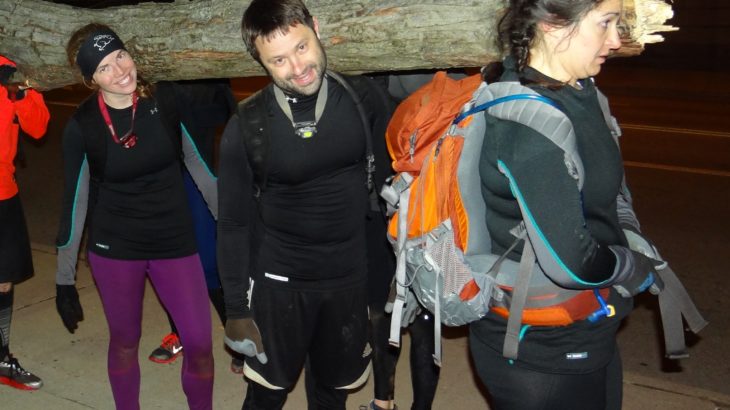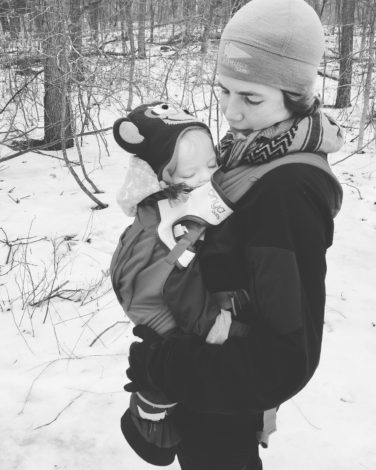Hiking in the Snow
"There's no such thing as bad weather, only bad clothing."
Looking out the window at two feet of snow blanketing the backyard and icy tree branches sparkling in the morning sun is magical and reminds me of my childhood. It makes me want to go outside and play! But then I think of how much work it will be to change all of my clothes and all of my one-year old's clothes... I take a deep breath, think of how beautiful the woods will be, and I start getting all our gear together.
Norwegians have a great saying: "There's no such thing as bad weather, only bad clothing." There are few things more miserable than freezing cold water sloshing around in your shoes. Being prepared with the right clothing can literally make the difference between tears and smiles, between "how did I get myself into this mess" and "just another day in the office."
Layering basics
I start by dressing myself, because I don't want my kid to get sweaty from being overdressed inside. I make sure that the layer closest to my skin is a wicking layer - a synthetic sport material or wool, but never, ever cotton. Since we're still breastfeeding, I also make sure that these layers can open easily. I have a specialized nursing sports bra from a maternity store, but it turns out that any "front crossover" sports bra works as a nursing bra (Ex Officio GNG crossover bra). For my top, I use quarter-zip shirts (REI Co-op screeline hoodie, Smartwool NTS Mid 250 zip). For hiking in 25-35 degrees F, I put my down jacket directly over this base layer, because I'm carrying my one-year old on my back and warm up really quickly. For below 25F, I'll layer with a down vest or a light sweater before putting on my jacket.
Pants
My go-to winter hiking pants are a fleece-lined soft shell model from Eddie Bauer. I don't think I can say enough about how magical it is to be out on the trail and have a warm layer of fleece hug your entire leg. You could also combine base layer pants or long underwear with soft shell pants, rain pants, or lightweight ski pants. It's easy to overheat when hiking, though, so if you're layering, I recommend experimentation!
Socks
For socks, I use calf or knee-length wool socks (Smartwool or Darn Tough). For gloves I use fleece or something relatively lightweight. My down jacket's hood is often enough for keeping my head warm, and it often comes off once I break a sweat, but for cold days I'll wear a hat.
Footwear
Footwear is probably the #1 most important consideration for winter hiking. You can survive if you're slightly under or over-dressed, but if you don't have the right shoes, you're probably going to get cold, wet, and miserable. This layer has to be waterproof, and that means not using stylish city boots but more heavy-duty winter boots. Personally, I invest in real winter hiking boots (I'm using Salomon Kaina mid CS waterproof winter boots and love them, and they're currently on clearance at REI.com). Any waterproof winter boot can work for hiking, but make sure it's flexible enough to allow for some ankle movement.
Traction
If you're hiking in just a few inches of snow, or on mixed terrain with dirt, snow, and ice, you should definitely look into getting either coils or spikes for your shoes. Coils (I use Yaktrax) are good for really mixed conditions, but if you're looking at a lot of ice, you need to go to the more heavy-duty microspikes (I use Kahtoola) that will allow you to literally walk on a sheet of ice as if it were a regular dirt trail. They both come with a pouch so you can carry them with you and decide whether or not you need them. I also always hike with hiking poles in the winter, because you never know when you might come across a patch of ice, and this extra stability gives me the confidence to go out in all conditions with a baby on my back.
Snowshoes
More than 6 inches of snow is where hiking definitely gets tricky. With every step you're going to sink into the snow, and this quickly becomes an insurmountable obstacle. That's when I pull out my snowshoes. It's still hard work if the snow is deep, but at least walking is physically possible! Mine are Pathfinder snowshoes from L.L. Bean, but anything lightweight and intended for combination walking-hiking will do–just don't get anything too technical, unless you're planning on climbing real mountains, because these can get pretty heavy.
Dressing the baby
Dressing my pre-walking baby, who's just coming along for the ride on my back, is pretty straightforward. Just as with myself, I dress her in a wicking base layer (we have an Ella's wool set and also a Patagonia synthetic set). For her second layer, I use pretty much any long-sleeve shirt and pants. Next come the wool socks and fleece booties–followed by fleece pants if it's below 25F–and then a hat and winter bunting.
Other winter weather gear tricks
For really sunny days, I use a winter hat with a visor to keep the sun out of her eyes (Patagonia baby reversible shell hat). If it's brutally cold, I put a Cozey7 Trailhopper right over the bunting. But if we're going to play in the snow, I use an Oakiwear rain suit over the bunting instead! I also like waterproof mittens and booties (we like Stonz) for extra warmth and protection. One more trick I've found useful is taking an umbrella out if it's snowing - that way snow doesn't pile up between the two of us when she's on my back!
It's definitely a lot of gear, but as long as it's kept in the same place, either in the same drawer, or in a special box or pouch, then it's pretty easy to get it all on in 5 to 10 minutes and get out the door! And while I've definitely longed for the outdoors when sitting inside, I have never regretted spending time outside! It takes preparation and practice, but there's no reason for northern Hike it Baby branches to shut down in the winter if parents and kids have the right gear!
 I'm happy here because I'm warm and mostly dry.
Often we spend so much time focusing on how to dress our children for outdoor winter adventures, we forget that we as caregivers need to focus on us as well. I’ve learned the hard way (multiple times) about dressing and layering for the weather.
In April 2011, I decided to run my first Tough Mudder. I wore a cotton tank top and shorts to an early, wet, cold spring event. I enjoyed my time but I know I had issues because I wasn’t wearing gear that worked for what I was doing. As I started to do more obstacle courses and moved into long events like GORUCKs, I had to get my gear and layering on point. I was constantly wet, cold and shivering. Things had to change. So, I experimented with gear during training until I had successfully figured it out.
I'm happy here because I'm warm and mostly dry.
Often we spend so much time focusing on how to dress our children for outdoor winter adventures, we forget that we as caregivers need to focus on us as well. I’ve learned the hard way (multiple times) about dressing and layering for the weather.
In April 2011, I decided to run my first Tough Mudder. I wore a cotton tank top and shorts to an early, wet, cold spring event. I enjoyed my time but I know I had issues because I wasn’t wearing gear that worked for what I was doing. As I started to do more obstacle courses and moved into long events like GORUCKs, I had to get my gear and layering on point. I was constantly wet, cold and shivering. Things had to change. So, I experimented with gear during training until I had successfully figured it out.
 it pulls moisture away from the skin, allows it to evaporate, and helps prevent chafing. Merino wool also wicks away moisture but it’s slower. The advantage is that merino wool is typically warmer and less stinky. Both merino wool and technical fabrics have good points about each. This article may help you decide which is right for you.
it pulls moisture away from the skin, allows it to evaporate, and helps prevent chafing. Merino wool also wicks away moisture but it’s slower. The advantage is that merino wool is typically warmer and less stinky. Both merino wool and technical fabrics have good points about each. This article may help you decide which is right for you. 



Comments